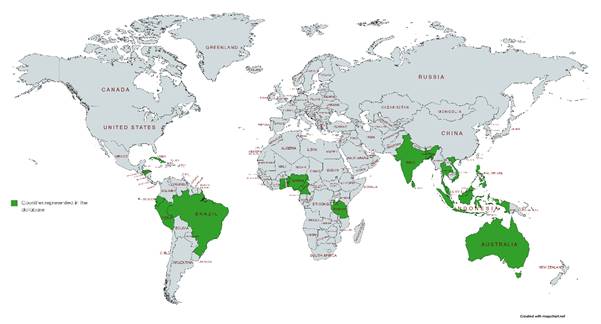Dataset Content
Details on compilation approach
The IAEA MODARIA II tropical dataset has been compiled from original source references reporting information on root uptake of radionuclides and stable isotopes by plants growing in tropical environments. It includes the tropical data originally collated for IAEA Technical Reports Series No. 472 (IAEA 2010) and new data for tropical environments identified through a literature search (covering the period 2006 – 2019), after evaluating the data against the Köppen-Geiger climate classification (BECK et al. 2018).
The data have been compiled as individual measurement values where available from source references or otherwise as reported average values with associated uncertainty (standard deviation) and the number of measurements. The data are not further summarized from the source references. Summary values of concentration ratios were calculated and presented in TECDOC-1979 for each element by plant group, plant compartment and soil group.
The data relate to sites exhibiting equilibrium conditions between the movements of radionuclides and stable isotopes into and out of the relevant environmental compartments. Data for dynamic or rapidly changing conditions are not included.
The data have been quality checked against original source references for errors. Source references have been evaluated for descriptions of equipment, procedures and controls relating to data quality, and the presence or absence of such information noted with each record in the dataset.
Source references are identified by unique reference numbers. Full bibliographic details are provided in the associated ‘Source References’ file and in IAEA TECDOC-1979 (2021).
Tropical dataset coverage
The dataset cover three tropical (class A) climate subclasses under the Köppen-Geiger climate classification: rainforest (Af), monsoon (Am) and savannah (Aw), with the division based on rainfall. Excepting some minor adjustments, this compilation follows the same general approach as TRS 472 to classify plants and soils based on crop type and on mineral and organic matter content. The main plant groups (and subgroups) included are: cereals, maize, rice, leafy vegetables, non-leafy vegetables, leguminous vegetables, root crops, tubers, fruits (woody trees, non-woody trees, shrubs, herbaceous plants), grasses, herbs, medicinal plants (woody trees, non-woody trees, shurbs), other crops (cacao beans, coffee beans, peanuts). The species assigned to each group are listed in Annex I. The primary means of classifying soils was based on the percentages of clay, sand and organic matter as specified in TRS 472.
IAEA’s MODARIA II tropical dataset contains over 7000 rows of information and includes data for:
(a) Thirty-six (36) elements (Al, Am, As, Ba, Ca, Cd, Co, Cr, Cs, Cu, Fe, Hg, K, La, Mg, Mn, Mo, Na, Ni, P, Pb, Po, Pu, Ra, Rb, S, Sb, Sc, Se, Sm, Sr, Th, U, V, Y and Zn);
(b) Twenty-one (21) countries (Australia, Bangladesh, Benin, Brazil, Cameroon, Cuba, Ecuador, French Polynesia, Ghana, Honduras, India, Indonesia, Malaysia, Marshall Islands, Nigeria, Peru, Philippines, Sri Lanka, Tanzania, Thailand and Vietnam) (see Figure 1 below);
(c) A range of environmental areas (contaminated sites and natural and semi-natural sites including coral atolls, rainforests and savannah) and land uses (agriculture, home gardens, urban areas and industrial zones); and
(d) More than 100 species of plants (many of the species are widely used as food crops in tropical environments, such as Amaranthus, Brassica, Ficus, Manihot, Musa, Oryza, Solanum and Vigna, while several permit direct comparisons with crops grown in temperate environments, including bean, cabbage, citrus, maize, potato, sorghum and wheat).
The plant groups in the MODARIA II tropical dataset with the most extensive information are fruits, herbs, leafy vegetables, non-leafy vegetables and rice, while information is more limited for cereals, maize, grasses and leguminous vegetables.

FIG. 1. Countries represented in the IAEA’s MODARIA II tropical dataset (adapted after IAEA TECDOC-1979).
